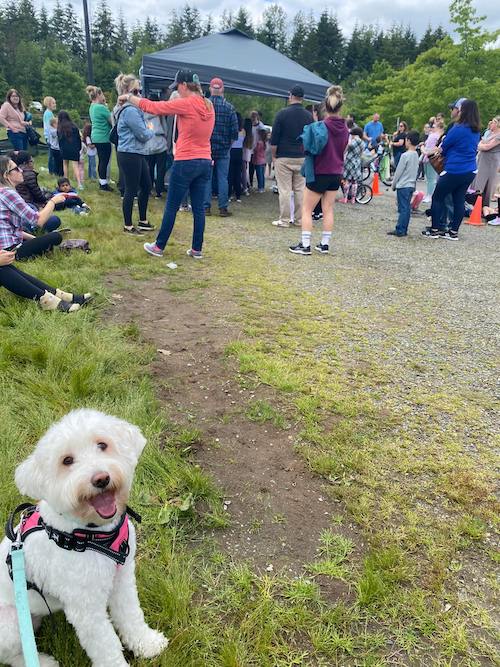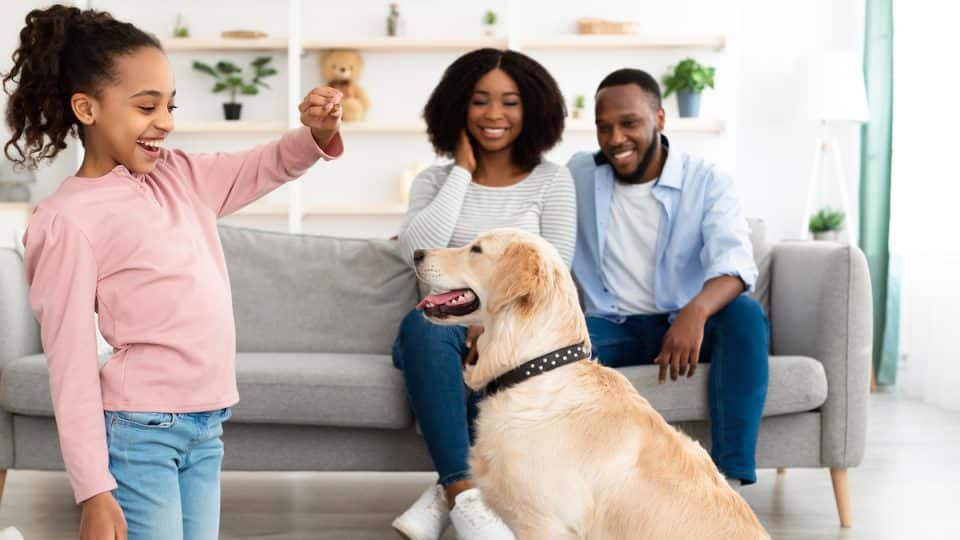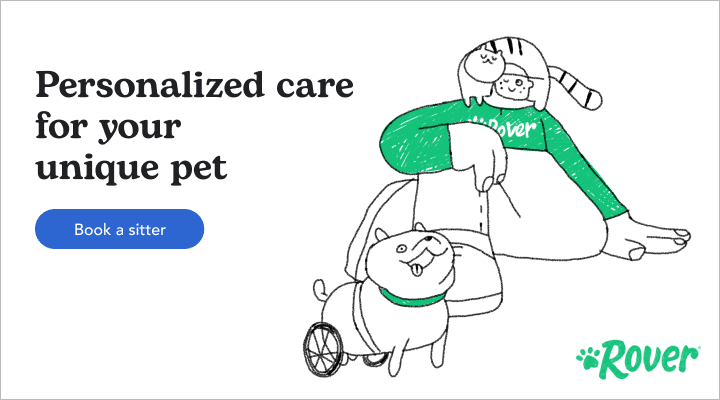- This post contains affiliate links. Read more here.
- Not a substitute for professional veterinary help.
Disclaimer: GoodPup is a Rover subsidiary.
From online college degrees to certifications, learning virtually has grown in popularity in recent years—and it’s not just for humans anymore. More and more pet parents are opting to train their pups online due to time, cost, and location constraints.
But is online dog training as good as in-person training? Does it really make a difference? And is it worth the investment in time and money? We turned to the experts to find out.
How Does Online Dog Training Work?
Most online dog training begins with an initial assessment. In either a video call or an online intake form, you’ll provide your pup’s basic details like age, health, breed, and behavior. Then you’ll share the skills you’ve mastered so far and what you’re hoping to accomplish next.
Once you complete this initial consultation, your online trainer will come up with a detailed training plan for your dog. You’ll also set up a schedule with your trainer and be given homework to complete between each virtual session.
Some online training programs offer group classes and courses that are general or specifically designed for a particular type of dog or skill (think trick training, puppy foundations, or dog reactivity).
Others provide private sessions, like GoodPup—a dog training app that includes weekly video calls with a certified and vetted trainer. Between sessions, the app provides tailored training guides and a daily log to keep you on target. Added resources include a library of training materials and an unlimited 24/7 chat feature to get answers any time from a professional network of trainers and vets.

Online training apps, like GoodPup, make it easy to find time in your busy schedule to meet with a professional trainer.
How Virtual Training Differs from In-Person Training
The obvious difference between online and in-person training is that it takes place in your own home, which can make some pet parents a little dubious of its effectiveness out in the real world.
But that’s the beauty of it all, says Tina Walker, Manager of Training Development at GoodPup. “First we work to develop the necessary communication in non-distracting settings such as the home,” she explains. “Once established, virtual training can then be taken on the road, to backyards, parks, coffee shops, and walks through downtown.”
She also points out that one of the biggest differences with online training is that it puts the pet parent in a unique position where they have to learn how to think like a dog trainer and communicate with their dog—ultimately helping build a deeper relationship and bond with their pup.

Good girl Remy is very happy to take her online skills out into the wild.
Types of Dogs That Can Benefit from Online Training
Walker says that online dog training is great for a huge range of dogs, from pups who need basic training to pets with specific behavior concerns. Any pet parent that has certain goals for their pup can see their dog benefit—even if that’s just having another fun activity to do together at home.
“I guarantee you’ll be amazed at what you learn about your dog and maybe even about yourself and what you’re capable of, too!” she says. “Even if it’s not what you’re looking for, you’ll have had a new indoor activity to do with your dog every day and maybe leave with a few new tricks up your sleeve.”
For dogs with particularly sticky issues like aggression, resource guarding, and generalized anxiety disorder, a veterinary behaviorist is also a good choice. As Lauren Novack of Behavior Vets explains, veterinary behaviorists that offer online services can be a wonderful resource for dogs working through behavior modification.
“In these scenarios, having a new person in their space only causes stress for the dog, which inhibits learning. Working virtually allows the trainer to see what is happening without their presence interfering and changing the dog’s behavior,” she explains. “And it allows the trainer to incorporate those scary things in an appropriate way, at the appropriate time, instead of right up front when the dog might not be ready yet.”
Pros and Cons of Online Training—What Experts and Pet Parents Say
There’s a lot to like about online dog training, plus a few watchouts:
- Pro: Inclusivity and accessibility—people whose locations or schedules prohibit in-person training can participate
- Pro: Affordability—with no travel costs, online training is often cheaper
- Pro: Flexibility—it’s a lot easier to schedule and reschedule virtual sessions and work around life’s unpredictability
- Pro: Immediate feedback—a lot of virtual training programs let you chat with professionals at any time, giving you feedback and resources in between sessions
- Pro: Low-stress setting—many dogs behave differently with a trainer present; online training lets your trainer see their natural behavior with you
- Con: Limited setup resources—if you’re contemplating serious agility training or rigorous socialization work, it can be easier to go to a trainer who has those resources set up ahead of time
Pro: inclusive and accessible
One of the biggest perks of online training is its inclusivity and accessibility. All you need is a reliable internet connection to get you started. This ease of access can be especially helpful for people who don’t have a professional dog trainer or behaviorist nearby.
This was the case for pet parent Linda Bang and her new Sheepadoodle puppy Remy, who she brought home during the height of the COVID 19 pandemic.
“I wouldn’t necessarily say I chose online dog training,” she jokes. “Given the circumstances in which Remy was brought home (mid-global pandemic, no availability), I believe online training chose me.”
However, Linda says she’s been pleased with all the resources, as well as the accountability, that virtual training has provided. “It really set us up for continued success as both puppy and humans continued to learn and grow,” she says.

Linda used online training to transfer Remy’s crate skills she learned as a puppy to a portable crate to prepare for their first beach vacation together.
Pro: affordable and flexible
Virtual training is also usually more affordable than in-person training, since trainers don’t have to factor travel time and costs into their pricing. And it’s more flexible, letting pet parents and their pups work at their own pace—which can be especially helpful for frustrated learners or pet parents with busy work/life schedules.
The cost-effective nature is what led Hannah Carver and her Standard Poodle Winnie to an online puppy course. “Training virtually was a great option because it was very flexible and worked with our schedule,” she says. “It also was less expensive than working with someone in person.”

Puppy Winnie and her human go for a socialization outing on their own time.
Pro: immediate and detailed feedback
Solidifying new behaviors can be difficult, so having immediate online support can really make a difference in your training journey, as Mindy Waite, Ph.D., Certified Dog Behaviorist at Senior Tail Waggers points out.
“Depending on how the trainer has set up the training experience, online training can provide a lot more immediate or consistent feedback,” she says. “For example, online training often requires the owner to submit videos of the behavior and/or their training, which allows the trainer to provide feedback relatively quickly as opposed to waiting for the next in-person session.”
Pro: low-stress and focused setting
When training in person, adding another human to the mix can sometimes skew reality for dogs and completely change their normal baseline. They could be excited and have a hard time focusing on their handler or start to show fearful and stressed behavior. Not to mention the added stress and distractions that impact less confident pet parents in real time.
“Virtual training allows the dog to focus solely on their guardian, whereas having the trainer come into the home often results in the dog paying attention to or getting distracted by the trainer,” Dr. Waite says. “Working virtually can avoid stress for both the human and dog while still providing the pet parent with critical training assistance.”
Con: limited resources for setups
Although Dr. Waite is a proponent of online dog training and is currently conducting scientific research on its benefits, she does think there are certain situations where it’s limited.
“I feel strongly that online training can work really well for a wide variety of behaviors, and the success is very dependent upon how the training is set up. Nevertheless, I do think that certain kinds of training might work best in person,” she says.
“For example, anything that requires expensive equipment and safety precautions, such as introducing beginners to agility. Or anything that requires specific socialization setups and in-the-moment management, such as puppy socialization classes.”
This is what ended up happening with Hannah and Winnie. “We reached a point in our training that I felt we needed in-person assistance,” Hannah says. “On a personal level, I was looking for someone I could meet face-to-face to give me more confidence handling my reactive dog in the real world and also comfort me through some of our difficult times.”
So, Does Online Dog Training Work? Final Verdict
Finding the right trainer for your dog can often feel daunting, especially if you have limited access to professionals and classes because of your time, budget, or location. Virtual dog training can provide an excellent solution—offering affordability, convenience, immediate support, and a comfortable setting for both you and your dog to learn.
While some pet parents may need in-person training for setups in the wild, they’ll still need the foundations to get them there. And what better way to build those skills than in the comfort of your own home and with immediate access to a support team?
Linda says it best while recounting Remy’s early “beast of a puppy” days. “Raising a puppy can feel intimidating and lonely, which makes us feel desperate for connection, and maybe even a little sympathy,” she says.
“I think technology and social media have allowed us to connect with people in more meaningful ways. And having virtual training resources available as an option just opens opportunities for people who may otherwise not have other avenues to explore.”
How To Pick an Online Trainer
Just like with in-person training, you’ll want your online trainer to be credentialed. Anyone can say they’re a dog trainer—but professionals should have certifications.
For basic training and common behavior concerns, the following are especially helpful:
- KPA CTP
- IAABC-ADT
- CTC
- VSA-CDT
For specific anxiety concerns, consider looking for additional certifications:
- CSAT, Certified Separation Anxiety Trainer
- FFCP, Fear Free Certified Professional (good for handling concerns and anxiety)
For concerns about big reactions—sometimes serious ones, like lunging and biting—consider going up a tier, to a Certified Dog Behavior Consultant:
- CBCC-KA
- PCBC-A
Finally, for dogs whose behavior concerns have medical overlaps or for especially serious concerns, consider a veterinary behaviorist or a certified animal behaviorist:
- DACVB (can prescribe)
- CAAB (can’t prescribe)
For more on the different kinds of credentials out there, check out “What Do the Letters in a Dog Trainer’s Credentials Actually Mean?”
You’ll also want to find a trainer who is a good fit for you and your pup on a personal level. A lot of online trainers are open to a free preliminary consultation, in which you can ask them some questions about their approach and personal style. Remember, you don’t have to go with the first trainer you find. You can always shop around or commit to one session before deciding on the full package.






